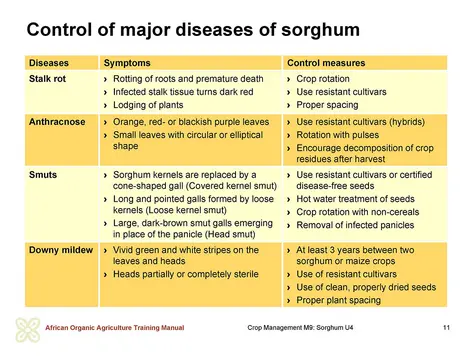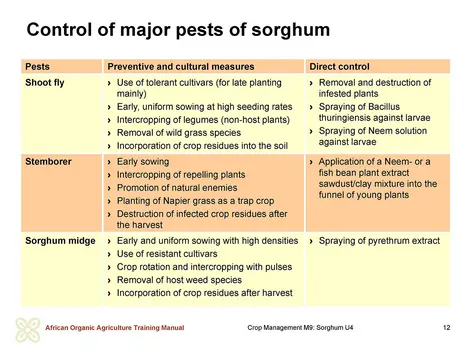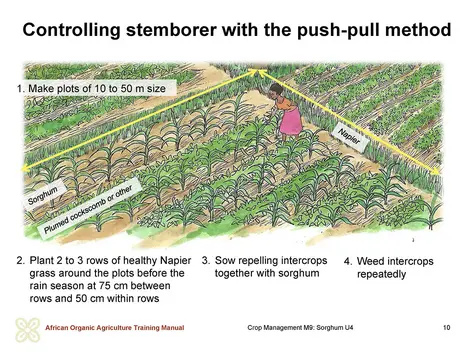Effective pest management
Sorghum is prone to damage by various insect pests and birds. Most insect species that infest sorghum occur widely and do not attack sorghum only, but several wild and cultivated grasses like maize, sugarcane or millet. Most insects appear at a specific stage of crop development: some feed on the leaves of seedlings, some bore into the stem causing a dead heart, many feed on the foliage during the vegetative stage, some suck the sap from leaves, some species damage the panicle at flowering, and some feed on the developing grain inside the glumes. Among the most important insect pests are the shoot fly and stemborers. The larvae of the shoot fly attack the shoots of seedlings and tillers, and cause dead hearts, whereas stemborers cause damage in all crop stages. The leaves are attacked by army worms (Spodoptera and Mythimna spp.). Larvae of the sorghum midge feed on the young grains in the panicle. Head bugs suck on the developing grains, which results in yield loss, grain deformation and discolouration, and infection by moulds. Among the birds, especially Quelea quelea can cause important yield losses. Regular monitoring and proper pest management are necessary to avoid yield losses in sorghum. In Africa the focus of pest management in sorghum is on proper application of preventative and cultural measures. Direct control of pests is not common. Pest management measures include the use of early-maturing cultivars, early planting and rotation of sorghum with non-host crops. Early sowing is particularly important, as it helps to avoid large insect populations at times when plants are most susceptible to damage. Cultivars with a good resistance are available for sorghum midge only. But cultivars with low levels of resistance to other pests exist. Sorghum is also very susceptible to damage by storage pests like weevil (Sitophilus oryzae), flour beetle (Tibolium castaneum) and grain moth (Silotroga cerealella).
Management of the common pests in Africa:
Shoot fly (Atherigona soccata): The larvae destroy the growing points and stems of young sorghum plants, which results in dead hearts. When temperatures are moderate and humidity is high during the rainy season the population of the shoot flies increases rapidly. Therefore, infestations are high after the rainy season. Between seasons, the flies hide on the tillers of remaining sorghum plants and alternative grass hosts. The carry-over of the pest from one season to the next is reduced by mixing the crop residues into the ground after harvest, and by maintaining a proper crop rotation or ensuring sufficient fallow periods. The use of tolerant cultivars, where available, or the inoculation of sorghum seeds with the bacteria Azospirillum and Pseudomonas considerably reduces shoot fly damage. Cultural control measures that reduce shoot fly damage also include early, non-staggered planting, establishing a high plant density, intercropping of sorghum with legumes or especially garlic, ensuring the availability of sufficient moisture and nutrients in the soil, delayed thinning, and removal of wild grass species which can serve as hosts. Plants with shoot fly damage should be removed during thinning and destroyed. In cases where plants are attacked and at high risk of damage, it is possible to spray with Bacillus thuringiensis or Neem extract. Stemborers (particularly Busseola fusca, Chilo partellus and Sesamia calamistis): These insects prefer sorghum, but also attack other cereals and grasses like sugarcane and maize. The larvae feed on the growing points, leaves and stems of the plants at different growth stages. Attack can result in major losses. The symptoms are similar to those of shoot fly, but occur later in crop development. Other symptoms are rolled leaves in the vegetative stage and tunnelled stems in later stages of crop growth. Late attack in the generative phase may result in chaffy heads and, in severe cases, the peduncles may snap. Stemborers pupate in the stems or between the stem and the leaf sheath. The insects can survive from one season to the next as fully grown larvae in stems. Cultural practices to reduce stemborer attacks include early, non-staggered sowing of sorghum, promotion of natural enemies, intercropping with millet (as adults do not lay eggs on millet stems) and destroying the residues after harvest to kill the caterpillars. Repeated application of Neem kernel powder or the leguminous Fish bean plant (Tephrosia spp.), mixed with sawdust or clay and placed into the funnel of young plants can be used to control stemborers if major damage is expected.
The ‘push-pull’ strategy, which was originally developed for maize-based farming systems in Eastern and Southern Africa, is also effective against stemborers in sorghum (see under weed management). To attract and kill the stemborers, some rows of Napier or Sudan grass are planted around the sorghum field acting as trap crops (pull). Additionally, repelling crops such as Desmodium spp. and Melinis minutiflora are sown between the rows of sorghum. These companion crops all have the added advantage of being useful fodder plants and Desmodium also supplies nitrogen to the soil and suppresses the parasitic Striga weed. Biological control of stemborers is possible with the wasp Cotesia flaviceps.
Sorghum midge (Contarinia sorghicola) is a very destructive pest of grain sorghum and occurs wherever the crop is grown. The adult is a tiny orange fly, whose larvae feed on the developing seeds, making the panicles appear blasted. Infections are common during the rainy season, among low density plant populations, or when there is a prolonged flowering due to staggered sowings and/or cultivation of varieties with different maturities, and the presence of alternative hosts. Late-flowering varieties often coincide with high midge population hence causing severe yield losses. High or very low temperatures and very dry conditions or high rainfall during flowering hinder the development of the pest.
If sorghum is sown early in the growing season using early-maturing cultivars and avoiding staggered planting, it usually escapes infestation. The use of resistant cultivars considerably reduces damage. Cultural practices such as appropriate rotation with non-host crops, and the intercropping of sorghum help to reduce pest damage. Infected crop residues should be destroyed by being fed to cattle, incorporated into the soil or burnt. Spraying of natural pyrethrum may be used, but is costly, difficult to apply, must be well timed to coincide with the flight of the adult insects and is less effective than other measures. After harvest the crop residues should be incorporated into the ground.
Head bugs (Calocoris angustatus and Eurystylus oldi) puncture and suck juice from the developing kernels, making them shrivelled, stunted and discoloured. The damaged kernels become infected with secondary pathogens, which further deteriorate the quality. Head bugs can be successfully controlled by growing tolerant cultivars. Guinea type sorghum is generally less affected by head bugs. Also, early maturing varieties are less susceptible.
Birds: Losses due to bird attack during grain-filling are widespread. Keeping birds away from ripening grains and harvesting in time are essential to limit losses. The cultivation of varieties with grains that have a purple seed undercoat containing tannin is another efficient control measure, as the birds ignore the bitter tasting seeds.



 tap and then scroll down to the Add to Home Screen command.
tap and then scroll down to the Add to Home Screen command.